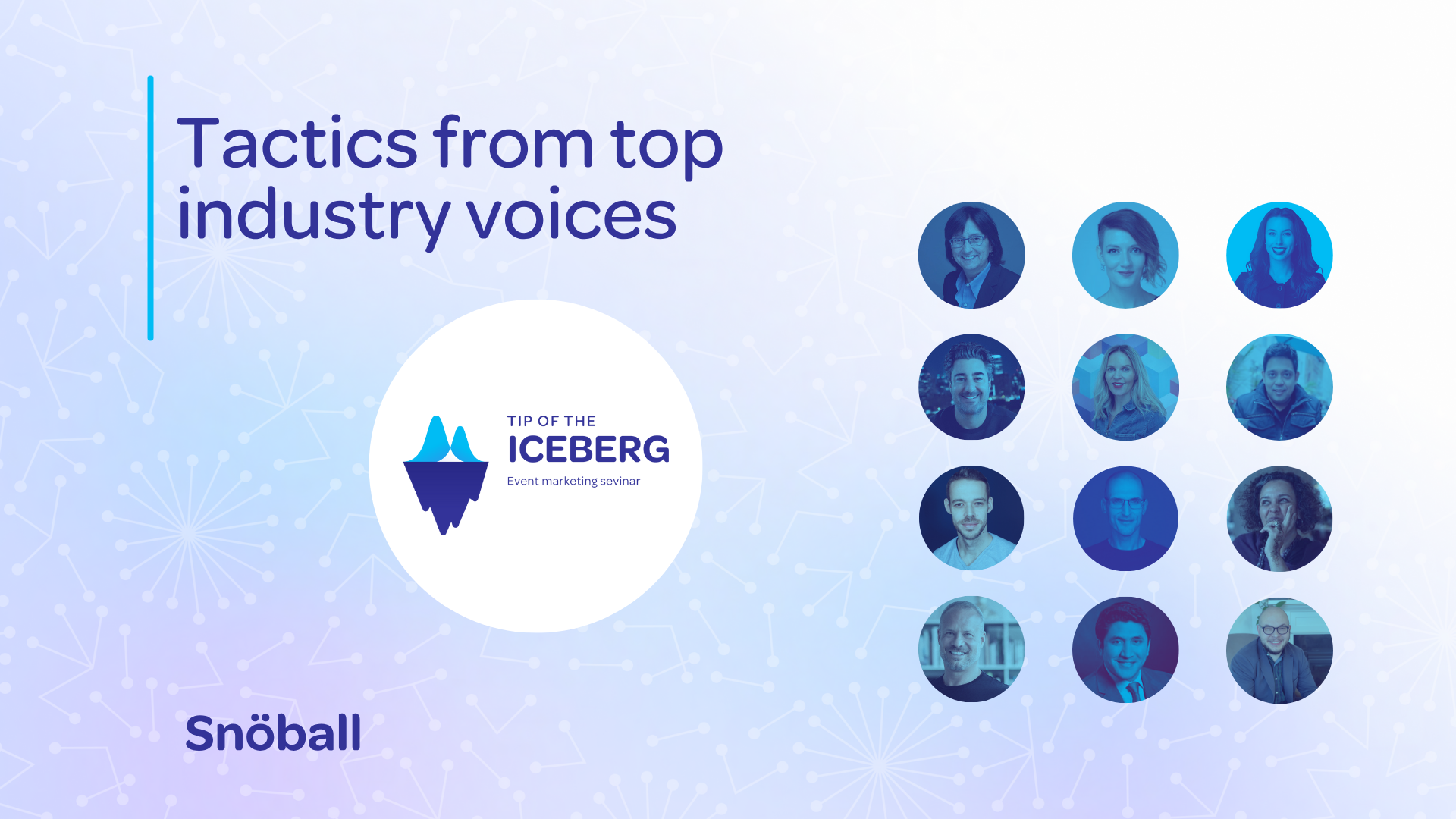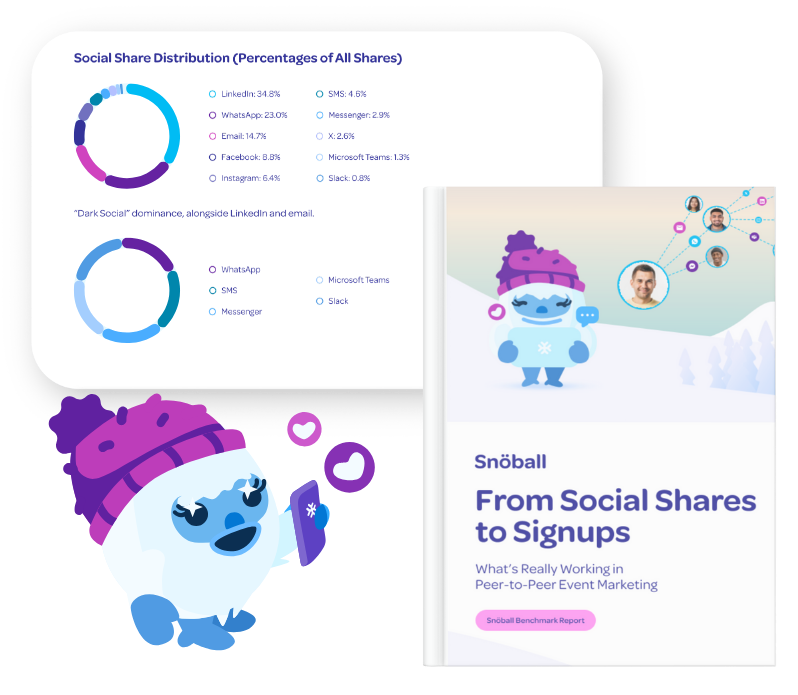
Real advice from real event pros across the entire event timeline.
What if instead of guessing what works in event marketing, we just… asked the people who are really doing it?
That’s the idea behind the Sevinars series, our seven-minute video series where event pros share pre-to-post marketing tips that actually move the needle.
Below, we’ve pulled together 12 best event marketing tips from Sevinar guests—from behavior scientists to field-tested CMOs—all organized by the natural rhythm of an event lifecycle: Before → During → After.
These aren’t fluffy thought bubbles. They’re real, repeatable tactics you can test, use, and evolve right now.
(And hey, if you’ve got unique insights of your own? Reach out to ian@snoball.events and we’ll see if it’s a good fit for a future Sevinar.)
Or just want to keep up with fresh takes from the field? Subscribe to our newsletter and get first dibs on new episodes.
❄️ What we will cover
Before we dive into the full breakdown, here’s your shortcut to the most valuable insights shared by industry leaders in the Sevinar series:
-
Use first-person CTAs for higher clicks
-
Align messaging with your audience’s core values
-
Address registrant remorse with emotional content
-
Equip speakers with content, not just codes
-
Be a curator, not a broadcaster
-
Create custom, high-quality content that feels personal
-
Prioritize authenticity over polish
-
Reuse event content as monetizable microcontent
-
Keep the conversation going between events
-
Give your speakers a game plan to generate leads
-
Incentivize participation with value-aligned offers
-
Always learn from—and elevate—your community
❄️ Before the Event: Getting People to Actually Register
Registration might seem like a numbers game, but it’s really a game of motivation. Before anyone signs up, they need to feel seen, understood, and compelled. And the best event marketers know how to spark that from the very first touch.
Getting a prospect to register for your event is ultimately a game of psychology, and our first tip is all about capturing that interest in your event and transforming it into event action. Now let’s talk about your call-to-action button and the message and position that will increase conversions.
1. Use Behavior-Driven CTAs That Convert
Getting someone to click your call-to-action isn’t about clever slogans — it’s about behavioral science. Most attendees don’t make decisions by analyzing every option. They skim, they scroll, they react. That’s why your CTAs need to be easy to understand, emotionally compelling, and written in a way that feels personal.
Here’s what Nancy Harhut, behavioral science marketing expert and author of Using Behavioral Science in Marketing, recommends:
“If you’re going to have a really good call to action, you want to make sure that it’s specific, action-oriented, benefit-driven — and written in the first person. Say something like: ‘I want to see the newest trends,’ ‘I’m in,’ ‘Sign me up,’ or ‘Give me exclusive access.’ Jay Schwedelson actually found that you can get a 28% increase in the click-through rate just by writing your CTA in the first person.”
But copy isn’t the only variable worth testing. Even the shape and color of your CTA button can affect engagement. Nancy points to research showing that rounded buttons tend to perform better than sharp, angular ones — they feel more welcoming and inclusive. Color matters too: your CTA should stand out visually with contrast, not just blend in with your brand palette. And keep things consistent between your email and landing page visuals so users know they’re in the right place.
Takeaway: Make CTAs personal and action-driven, test rounded shapes and contrasting colors, and match the visual experience from click to conversion.
2. Tap Into Valuegraphics to Truly Know Your Audience
Once you’ve crafted CTAs that drive action, the next challenge is knowing which message will resonate with which audience. Too often, marketers stop at surface-level insights like age, industry, or job title. But influence doesn’t come from who someone is on paper — it comes from what they value.
That’s where David Allison, founder of Valuegraphics, says most event marketers are missing the mark.
“Demographics tell us what people are. Psychographics tell us what they’ve done. But Valuegraphics — values — tell us how to influence behavior. That’s the missing piece we need if we’re trying to get people to do something new.”
According to David, our values act like an operating system for how we make decisions. They’re stronger than age or career stage and more predictive than past behavior. For example, you could have a group of senior-level medical professionals — but that doesn’t mean they all care about the same things. Some may value security, others adventure, and others connection — and each one will respond differently to your event messaging depending on those values.
To uncover values within your audience, David suggests asking three simple (yet powerful) questions:
-
Why do you go to work every day?
-
Why would you give away half of your lottery winnings?
-
What would your former self from 10 years ago want to say to you — and why?
When you spot patterns in the answers, you begin to build a value-based profile that helps guide not just your content, but your entire marketing strategy — from your emails to your event experience.
Takeaway: Don’t just market to titles. Market to what people care about. Tap into values to craft messages that influence behavior and drive registrations.
3. Prevent Registrant Remorse with Reassurance and Kindness
Once you’ve crafted messaging that aligns with your audience’s values, you still need to keep them excited. That’s where many event marketers unknowingly drop the ball.
As Sourabh Kothari, CMO of Lead2Pipeline, puts it:
“As soon as someone registers… they have fears. The right people won’t be there. The content won’t be for them. We don’t talk enough about registrant remorse.”
Sound familiar? That same psychological dip we feel after clicking “Buy Now” — Was this a mistake? Did I overcommit? — hits attendees too. They start to second-guess the event. Will the right people be there? Is the content really for me?
Instead of trying to re-sell them on logistics, Sourabh suggests tapping into emotional psychology — specifically three hormones that influence how we feel about a commitment:
-
Dopamine: Triggered by reward. Celebrate small actions like booking a hotel or selecting sessions. Show progress.
-
Serotonin: Linked to wellbeing and connection. Let registrants know others like them are attending, too.
-
Oxytocin: The “hug hormone.” Humanize your messaging. Trade power for kindness.
From confirmation emails to pre-event nudges, every message is a chance to replace anxiety with affirmation — not just you’re going to the event, but you belong there.
Takeaway: Don’t let registrants feel alone. Replace big, cold marketing with warm, thoughtful touchpoints that make them feel seen, safe, and excited to show up.
4. Turn Speakers into Strategic Influencers
Once your registrants feel emotionally committed, the next step is to keep the momentum going by surrounding them with social proof — and no one’s better positioned to help than your speakers.
But as Jay Schwedelson, founder of SubjectLine.com, points out:
“Most event marketers don’t leverage their speakers enough. They just give them a discount code. We flip it: every speaker gives a 30-second tip video and plugs the event.”
Too many event teams hand speakers a promo code and hope for the best. Jay’s team does the opposite. They treat speakers like trusted content creators — and it pays off.
They require speakers to:
-
Record a short video sharing an actionable tip related to their topic
-
Plug the event at the end
-
Post at least 3 times on LinkedIn
-
Like and comment on event posts
The results? Huge organic lift. Real value upfront. And most importantly, it feels like a conversation — not a promotion.
Jay also reminds us that most B2B influencer marketing comes from micro-influencers (people with under 100K followers). That means your speakers — even if they’re not famous — are your best-performing channel when activated strategically.
Takeaway: Equip speakers to influence, not just promote. A tip-first video strategy turns “I’m speaking at this event” into “Here’s something valuable — and if you want more, I’ll see you there.”
5. Curate Like a Critic, Not a Catalog
If the last few years have taught event marketers anything, it’s this: volume is not value.
Kathryn Frankson, Director of Marketing at Money20/20, put it plainly:
“You can’t just be the one going, ‘We’re the voice of the industry.’ You have to be the curator — of something people can’t just find on their own.”
Kathryn’s team leaned into this mindset with curated, story-driven stages at their Amsterdam event — each one designed around a specific theme like “The Exchange” for raw conversations, or the plant-filled “Planetarium” symbolizing growth.
That same specificity carries into their marketing. Instead of overloading the message with speaker counts or content volume, they build intrigue by selectively revealing what’s new, different, and valuable — and only to the right segments.
She explains the shift well:
“Going off some of the older event plays around volume of speakers or sessions isn’t necessarily appealing anymore… Event marketers are really being tasked with a level of product marketing and specificity they haven’t had before.”
Takeaway: The best event marketers don’t promote everything — they highlight what matters. Curate with intention. Segment with purpose. And lead with the details that make your experience irreplaceable.
6. Keep it human
Once your value proposition is clear, the next challenge is standing out — not with polish, but with personality. That’s where authenticity comes in. Instead of obsessing over camera quality or lighting, focus on real people sharing real enthusiasm.
Ross Cranwell, CEO of MilkPEP and founder of Milk Video, says that even in a sea of slick promotional content, raw, human videos still win.
“Don’t worry too much about being scripted or overproduced. People want to see the authentic side… especially for B2B businesses, which often don’t have much personality. Seeing the people behind the business builds trust.”
Ross encourages event marketers to lower their production standards — not their storytelling standards. It’s not about cutting corners, it’s about removing friction so more voices (like your speakers, staff, or attendees) can share quick, meaningful videos. Q&A formats, webcam recordings, and casual updates not only feel more natural — they also build emotional connection and credibility with potential attendees.
Takeaway: Authenticity builds credibility. Empower your speakers, staff, or ambassadors to share what matters — even if it’s scrappy. The human element cuts through.
🧊 During the Event: Creating Connection and Credibility
When the event kicks off, your job isn’t to sell — it’s to connect.
7. Design content that feels made for them
Once your message feels human, your next opportunity is to make it feel made for me — not just a generic broadcast. Julius Solaris, renowned event analyst and founder of Boldpush, emphasizes the shift in audience expectations, especially for virtual or hybrid experiences.
“If I’m attending virtual events these days, I want a premium YouTube experience… made for me, not just something I can find on YouTube.”
In a crowded landscape of content, attendees want something that’s tailored, intentional, and purposeful. Julius pointed out that delivering high-quality content doesn’t always mean big budgets — it means relevance. Whether that’s showing the best speakers in your vertical, offering downloadable takeaways, or formatting sessions like polished interviews, your audience should feel like the event was designed with them in mind.
The same mindset applies to on-site experiences too. Are the topics aligned to their challenges? Are speakers solving problems they care about? Do sessions feel binge-worthy or forgettable?
Takeaway: Today’s audiences expect more than access — they want personalized value. Don’t just fill the schedule. Curate an experience.
8. Give speakers a 4D game plan
On the flip side of this coin, not every event participant is there just to absorb content—many are there to deliver it. And for speakers, sponsors, and exhibitors, success often means one thing: pipeline.
That’s why it’s smart to treat your speakers like strategic partners, not just talent. If you help them approach your event with the right plan, you increase the odds they’ll walk away with real value—and want to return next year.
“One of our clients booked 30 meetings from a single event using a 4D framework: Data, Distribution, Destination, Direction.”
— Mason Cosby, Founder, Scrappy ABM
Mason Cosby developed a simple but powerful 4D framework to help speakers turn stage time into business outcomes. Here’s the breakdown:
-
Data – Who are you targeting, and what triggers outreach?
-
Distribution – How will you get in front of them?
-
Destination – What action or resource are you driving them to?
-
Direction – How are you tracking and measuring success?
Beyond the framework, it’s also about creating clear connection moments. Mason discussed how his own team used some direct communication on-the-fly:
“We actually pointed to our account executive during a session and said, ‘If you want help while we’re here, talk to me or our COO—we’re not here to sell you, we’re here to help you.’”
This simple on-site prompt gave attendees immediate clarity and encouraged post-session conversations—leading to warmer follow-ups and lasting impressions.
When you create space for your speakers to succeed—before, during, and after the event—you’re not just helping them. You’re amplifying your event’s impact, strengthening relationships, and making a compelling case for repeat participation.
Takeaway: As an event marketer or organizer, the more you equip your participants with frameworks like this, the more value they’ll get from your show—and the more likely they are to rebook, refer, and advocate for next year’s event.
☃️ After the Event: Squeezing Gold from Your Content
If pre-event is where the conversion happens, and during-event is where the magic is made, post-event is where the real compounding value begins.
9. Repurpose like a content machine
“Post-event, you have a golden opportunity to feed people content in microdoses… That’s a money tree, you’ve gotta shake the tree!”
— Dahlia El Gazzar, Founder, DAHLIA+Agency
Dahlia El Gazzar, Founder, DAHLIA+Agency makes her point crystal clear: if you don’t do something with the amazing content created at your event, you’re leaving money on the table. And not just in abstract brand equity — she’s talking real, monetizable opportunities.
Her advice? Think microdoses.
Chop long-form keynotes into snackable reels. Turn roundtable insights into downloadable reports. Cut, contextualize, and repackage by theme, topic, or vertical. According to Dahlia, people will pay to access curated content — especially if it’s positioned as insider access, organized by preference, or includes voices from peers or experts they missed.
She also suggests packaging high-performing breakout sessions or niche-topic panels alongside sponsored thought leadership to create gated assets or premium recaps — a potential upsell for partners and a valuable drip for your post-event campaigns.
And it doesn’t stop there. Dahlia says the chats (yes, the fire-in-the-room kind) are often the most overlooked content goldmine — especially for digital and hybrid events. Quote the chat. Summarize the themes. Make the buzz tangible.
“You get to know what your audience wants more of — and what they’ll pay more for.”
And perhaps her most important reminder: your internal event team is probably not the best group to own this.
They’re tired. They’re already onto the next event.
This post-event content strategy needs a dedicated owner — someone to shake that money tree.
Takeaway: Post-event content isn’t just for recaps. It’s a second wind, a sales tool, and a revenue stream. Repurpose wisely, distribute intentionally, and make the most out of what you already created.
10. Stay active between editions
After you’ve shaken the post-event content tree (thanks, Dahlia), what happens in the months that follow? Do you stay top-of-mind — or go radio silent?
Most event marketers ramp up promotion before the event, only to vanish afterward. But your audience’s attention doesn’t need to be binary — on or off. In fact, staying in touch between editions is one of the smartest ways to nurture long-term growth, relevance, and loyalty.
“It’s a classic example — before something comes up, a brand is launched, an event is being done — we ramp up communication. We tap all the channels, we’re preaching about it. And once it’s done? We close the lid and forget about it. Disappear. Which is bad.”
— Ali Akhtar, Marketing Data Analyst, Ottawa Safety Council (formerly of Informa)
Ali makes the case for an always-on marketing strategy, particularly one that leverages low-cost, high-impact channels like podcasting.
Why podcasting?
Because it allows you to have ongoing conversations in the spaces where your audience already spends time. Whether it’s thought leadership from industry partners, product innovation discussions, or sustainability trends, this type of content helps bridge the gap between editions and keeps your event brand alive year-round.
And it’s not just about podcasting — it’s about mindset.
Ali reminds us there’s a lot happening between events. Those moments are opportunities to keep building resonance, reinforce your positioning, and even spark unexpected conversions.
“The conversation can lead to another conversation. And if someone comes to us saying, ‘Hey, we want to be part of this. We want to attend, speak, sponsor’ — that’s a win. Even if it wasn’t a direct click or promo code.”
Takeaway:
Don’t just turn the lights on when it’s time to sell tickets. Keep the room warm. Whether through podcasts, newsletters, social content, or ambassador-driven shares, build a drumbeat that never fully stops. Your next edition starts now.
11. Be thoughtful with incentives
Incentives can help tip the scale in your favor — but not if they’re thoughtless. A generic $5 gift card might feel easy to send, but it rarely aligns with the audience you’re trying to win over.
As Aleksandra Panyukhina, Event Marketing Strategist, puts it:
“If you’re asking senior-level people to invest an hour… a generic $5 gift card doesn’t show value.”
The problem isn’t the size of the gift — it’s the signal it sends.
A random, low-value offer feels like an afterthought. And when you’re targeting VPs, Directors, or C-level leaders, their time is both expensive and carefully protected. A weak incentive can actually undercut your event’s perceived value.
Aleksandra reminds us that great incentives are about alignment, not extravagance. They should match:
-
The time commitment you’re asking for
-
The professional level of your audience
-
The tone and value of the event itself
“Depending on how large or small-scale your campaign is, I don’t mean value in terms of dollars — but relevance. What would they appreciate? What’s worth their time? You need to showcase that the event itself is worth it.”
And don’t overlook ease of use. If it takes five extra steps to redeem a code, your ‘thank you’ becomes an inconvenience. Instead, incentives should act as a bridge — a small gesture that amplifies the perceived value of the event, not detracts from it.
Takeaway:
Respect your audience’s time. Whether it’s a premium coffee delivery, an exclusive swag item, or even a charitable donation in their name, a thoughtful incentive is a reflection of your event’s professionalism and your understanding of the audience you’ve worked so hard to invite.
12. Why year-round marketing wins in B2B events
Too many event marketers treat promotion like a seasonal job — launching short bursts of activity in the lead-up to the event, then going quiet until next year. But that leaves a massive gap in awareness.
As Laura Davidson of Tag Digital points out, this strategy simply doesn’t align with buyer behavior:
“Your market is only in market for 5% of any given year, so you need to invest all year round. When that person comes to think about going to an event… you’re top of mind.”
That 5% stat should stop any event marketer in their tracks.
If you’re only marketing when your registration page is live, you’re missing the other 95% of the time your potential attendees are forming impressions — consciously or not — about your event, brand, and industry relevance.
Laura goes on to explain that “always-on” marketing isn’t about blasting ads 24/7. It’s about staying present in your audience’s world:
-
Publishing content they care about
-
Collecting first-party data while cookies disappear
-
Building brand affinity that pays off when the decision moment hits
And crucially: it’s about feeding the algorithms.
The more interactions your campaigns generate throughout the year, the better your platforms (and people) get at finding the next great attendee, exhibitor, or speaker.
“People are only paying attention to the content when the event isn’t on… That’s why you need to invest year-round.”
Takeaway:
Don’t just market your event. Build year-round visibility, value, and trust — so that when your audience is ready, your brand is the first one they think of.
Final Thoughts: Want to Share Your Wisdom?
What makes these tips powerful isn’t just that they’re creative—it’s that they come from marketers who are actively testing, adjusting, and iterating in the real world.
If that sounds like you (or someone on your team), we’d love to hear from you. Reach out to ian@snoball.events and we’ll see if it’s a good fit.
P.S.
Event marketing is evolving faster than a Sno-cone on asphalt. The best thing we can do? Keep learning from each other.
Stay chill ❄️





